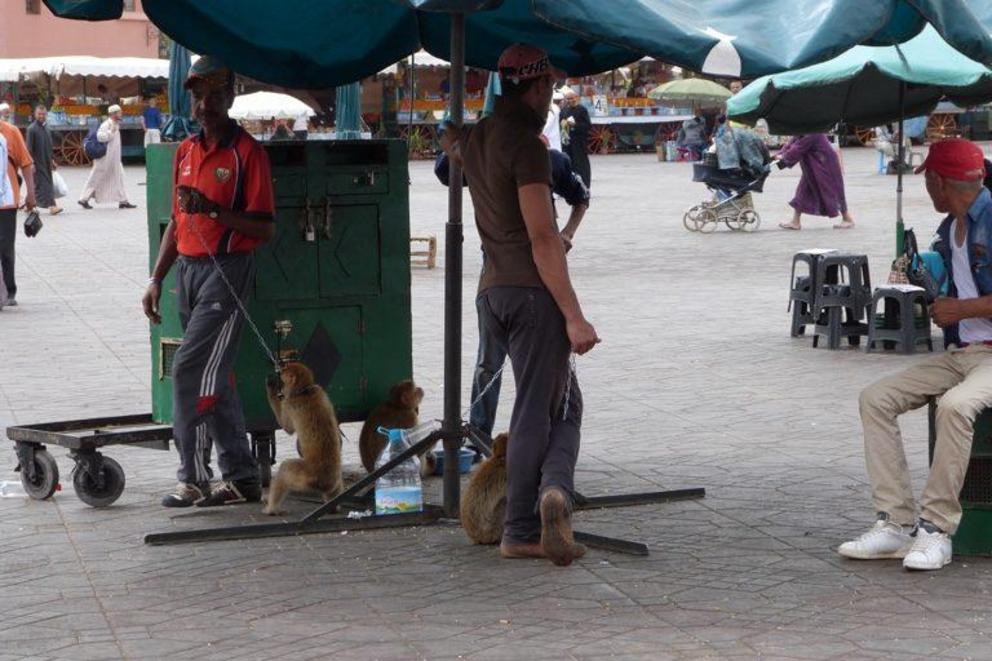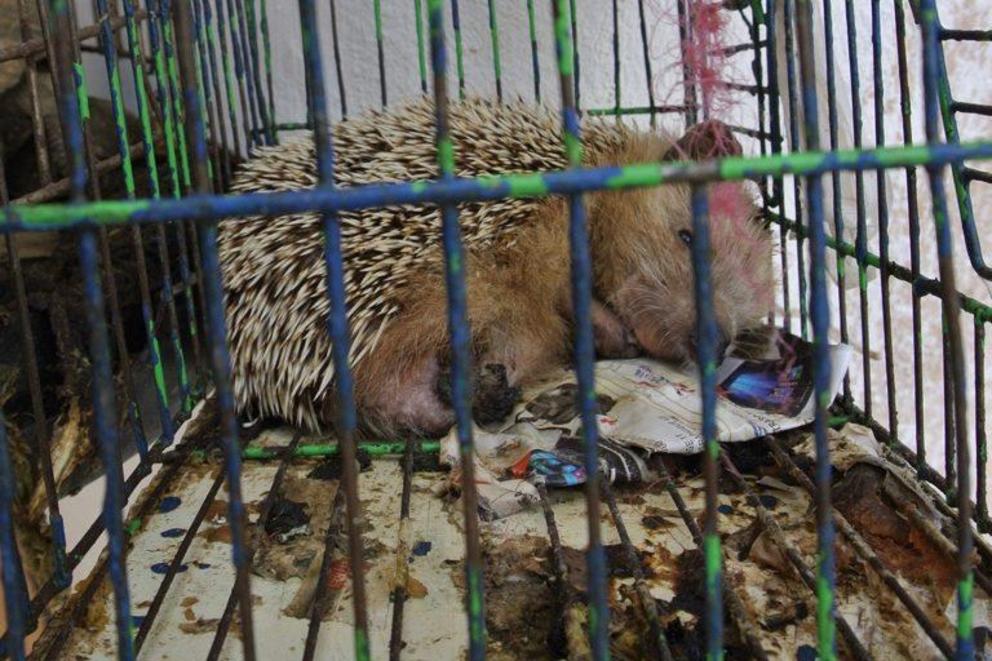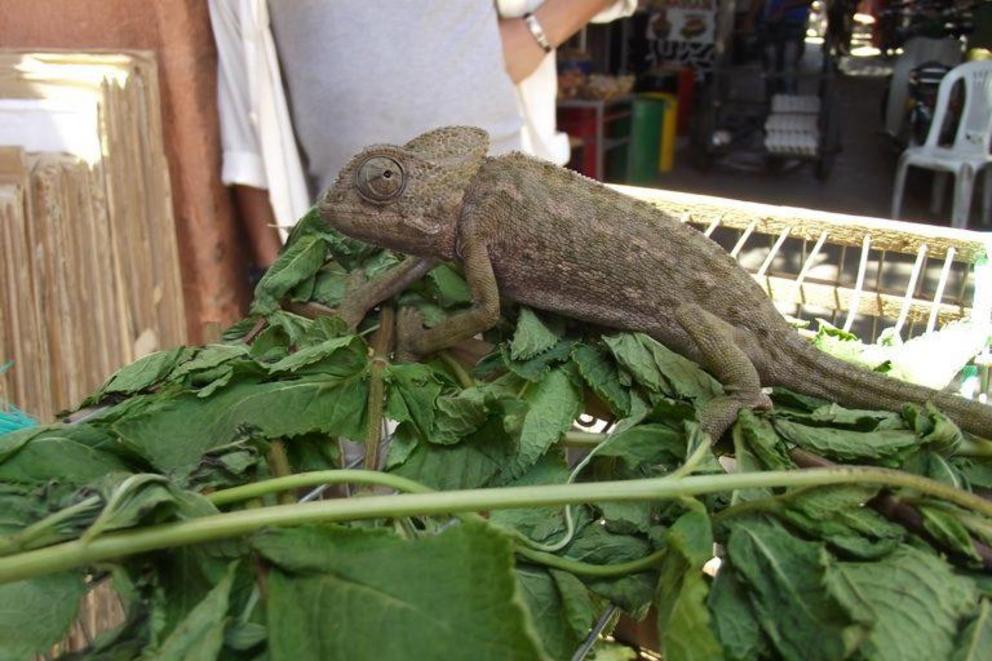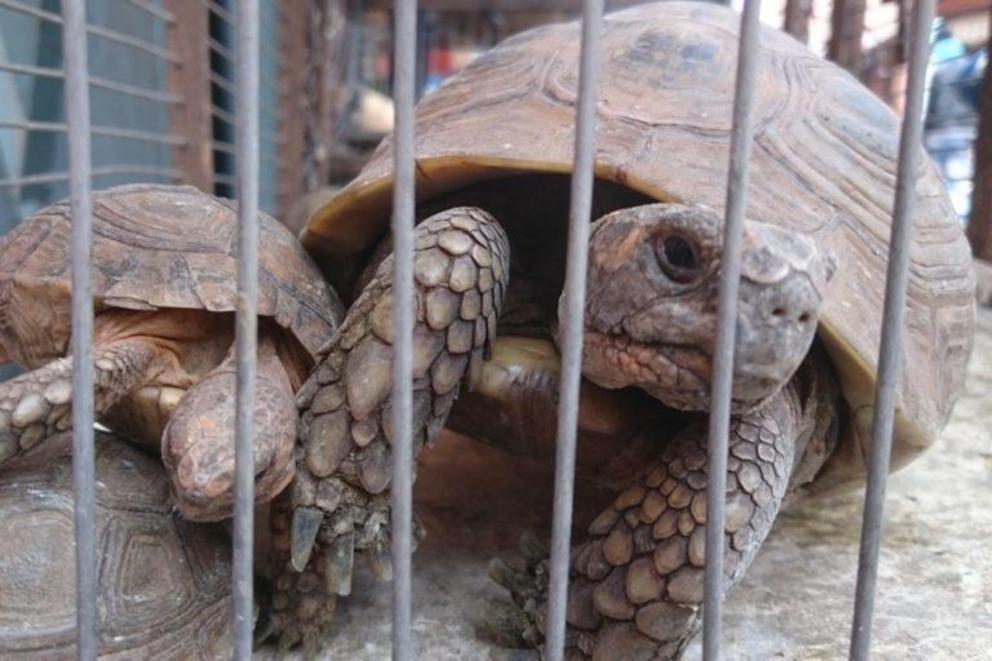In Morocco’s markets, conditions for wildlife are ‘universally poor’
In Morocco’s live animal markets, a wide variety of wildlife is available for sale. There’s the threatened spur-thighed tortoise (Testudo graeca), going for around $1, and the endangered Barbary macaque (Macaca sylvanus), on offer for about $500 or as a photo prop. There are North African hedgehogs (Atelerix algirus), Mediterranean chameleons (Chamaeleo chamaeleon), and Egyptian cobras (Naja haje) too.
But a common thread runs through this North African country’s bustling wildlife markets: animals are often kept in poor conditions without water, food and shade, a new study has found.

The market of Marrakesh has some of the highest numbers of wild-caught live animals in Morocco. Image by Daniel Bergin.
Daniel Bergin, a researcher from Oxford Brookes University, U.K., who focuses on the wildlife trade in North Africa, visited wildlife markets in Marrakesh, Fez, Casablanca, Meknes, Tangier and Rabat in Morocco a total of 40 times between 2013 and 2017. Over these visits, Bergin’s team recorded the conditions in which animals were being kept: whether they had access to appropriate food and water; whether they were able to control for exposure from heat or sun; whether the material of the floor of the enclosure was comfortable; whether there was sufficient space for them to move around in; and whether they were able to hide from stress.
The team scored the welfare of more than 2,100 animals, and found that the conditions of wild animals that were on sale or being used for entertainment in Morocco were almost universally poor.
“Baby monkeys were picked up and carried by a chain that was fixed around their neck even though it clearly caused them a lot of pain and distress,” Bergin said. “Tortoises were often piled together in such a way that they could not all touch the ground and we once found a sack full of tortoises that had seemingly been abandoned in the corner of a market. The tortoises were desperately trying to get free, but there seemed to be no immediate intention to move them, even to put them in crates.”
What disturbed the team the most was seeing animals with no food and water, left exposed to the heat of the direct sun without any shade to find respite in. “These animals were dying slow, painful deaths, totally unnecessarily,” Bergin said.

Juvenile barbary macaques. Image by Daniel Bergin.
The team, however, did not physically inspect the animals. This made it impossible for them to determine if the animals were carrying diseases or not, the researchers report in the Journal of Applied Animal Welfare Science.
“Although this would have been useful and interesting information, it would not have greatly affected their welfare in the markets, which was the focus of this study,” Bergin said. “All of the necessary information to make this assessment could be collected non-invasively. Poor welfare is clear for all to see. Disease transmission from wild animals to humans and other animals, however, is an ongoing and serious issue and is a great cause for concern.”
Conversations with vendors revealed they were largely unaware of the animals’ needs. Much of the food available was rotting and consisted of only lettuce and mint leaves, despite the animals eating a wider variety or different kinds of food in the wild. The spur-thighed tortoise, for instance, is known to eat at least 34 species of plants in the wild, the researchers write, while the Barbary ground squirrel (Atlantoxerus getulus) eats mostly fruit, seeds and nuts.
“Vendors often incorrectly said that tortoises do not need to drink water, or that chameleons only eat mint leaves (they actually eat insects and cannot survive on a diet of only leaves),” Bergin said. “We do not believe that people want to intentionally hurt the animals, but they need to have a better understanding of how to keep them in good health.”

Hedgehogs are sold as pets and for medicinal purposes in Morocco. Image by Daniel Bergin.
Improving the welfare of wild animals in markets has conservation benefits, too: If fewer animals die in markets, there is less need to constantly remove animals from the wild, the researchers say.
Much of the trade in Morocco’s wildlife markets is illegal. Of the 2,113 animals the team saw in the markets, 1,970 were illegal to sell in the country, with spur-thighed tortoises accounting for nearly 94 percent of the animals seen.
“Despite the illegality of this trade, no attempt is made to hide any animals, as repercussions from new laws are clearly not enough to act as a deterrent due to a lack of enforcement,” Bergin said.
Morocco is a member of the World Organisation for Animal Health (OIE), an intergovernmental organization responsible for setting animal health standards to improve animal health and welfare. Current Moroccan laws, though, do not reflect the commitment of the government to animal welfare, the researchers write.
In 2013, the Moroccan government proposed a law prohibiting the mistreatment or abuse of animals in captivity, with fines of up to 20,000 dirham (about $2,000). This yet-to-be-enacted legislation, however, “does not appear to apply to mistreatment due to negligence and does not incorporate all the OIE’s guiding principles and standards for animal welfare (World Animal Protection, 2014),” the authors write.
“The animal welfare law was being discussed in conjunction with veterinary health inspections of food products of animal origin and other partially-related concerns,” Bergin said. “During the standard rewriting of these laws, the welfare aspect was quietly dropped from consideration and appears never to have resurfaced. We believe that by drawing attention to this important provision again, we can bring animal welfare back to the discussion.”
Mongabay contacted the OIE Sub-Regional Representation for North Africa for comment, but there was no response as of the time of publishing this story.

Vendors at Morocco’s wildlife markets mistakenly believe that chameleons can live on just mint leaves. Image by Daniel Bergin.
Bergin’s team also found that almost every vendor selling illegal wildlife in Moroccan markets had other sources of income, such as selling herbs, souvenirs, domesticated animals and artificially propagated plants, or other goods — suggesting that wildlife forms only a small portion of their income.
“If traders were financially reliant on these animals, we also believe that they would make some attempt to keep them alive,” Bergin said.
“We believe that removing the illegally-traded wildlife would not significantly affect the majority of people — be it traders or customers,” he added. “The Moroccan government has decided that these animals are not going to survive in the wild if they continue to be sold at the current rate: we would like them to take the next logical step and put a stop to it.”

Tortoises, the most commonly sold animals in Morocco’s wildlife markets, are rarely provided with food or water and are often tightly packed into cages. Image by Daniel Bergin.
For full references please use source link below.
